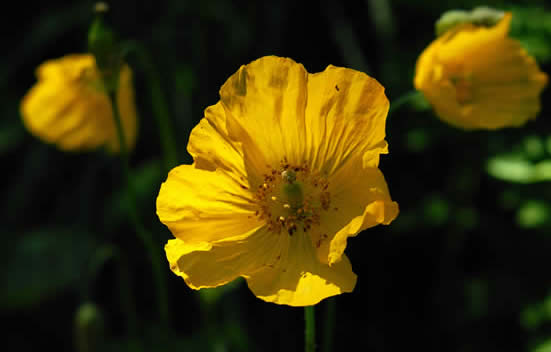Welsh poppies
The Welsh Poppy Meconopsis cambrica is a distinctive flower that we see in the French Pyrenees in both June and September. Here, the most reliable area to see them is the woodland edge in the Bué valley, close to our base at Gèdre.
It’s also well-known as a garden plant, especially in western and upland Britain, and is a glamorous member of our native flora, found in Wales and a few places in southwest England.

Welsh poppy (Ivan Nethercoat, June 2009)
A study recently published in British Wildlife (see right), using molecular information, asks three questions . . .
Is the Welsh poppy really a Meconopsis?
Other Meconopsis poppies, such as the brilliant blue Meconopis grandis, are found in or near the Himalayas. The Welsh poppy appears like a Meconopsis with stigmas on an elongated style, rather than on a flat disc like true poppies. This study, after looking at molecular data, concludes that the Welsh poppy has evolved from true poppies, with the structure probably due to convergent evolution. Following the historical or genetic trail for scientific names, the usual pattern, don’t be surprised to see Meconopsis cambrica returned to its former name of Papaver cambricum.
Are the native and garden plants genetically distinct?
DNA analysis was done on five groups of plants from areas known to have had Welsh poppies in the 19th century or earlier, and seven groups near roads or houses. The findings showed the expected genetic differences between native and escaped/garden poppies. There were two anomalies. One was Cheddar Gorge, where once native plants now seem to be of garden or mixed origin. The second was on two roadside populations in Wales where there was evidence of gene flow from wild poppies.
What links are there between British and European Welsh poppies?
The study concluded that the native Welsh plants are linked to those in the Massif Central, western Pyrenees and part of the Cantabrian mountains. There is also a southerly group in the eastern and central Pyrenees – presumably included those we see near Gèdre – and elsewhere in the Cantabrian Mountains. They also found that our garden Welsh poppies are from the southerly group in the eastern and central Pyrenees – those wild plants that we see on our holidays.
Chris Durdin, November 2012
More nature notes . . . . . . . . . . . . . . . . . . . . . . . . . . . . . . . French Pyrenees

